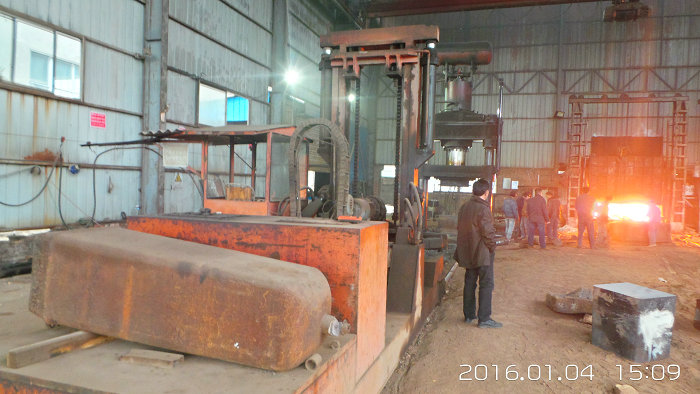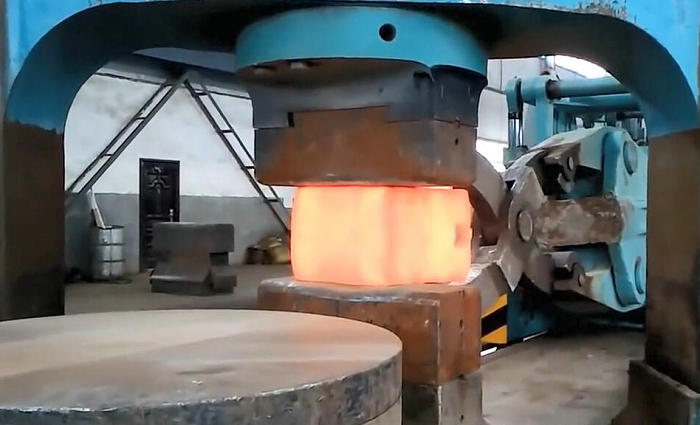CNC Machining Free Forging Steel Parts
Free Forging Process Is To Use Impact Force Or Pressure To Make The Metal Deform Freely In All Directions Between The Upper And Lower Anvil Surfaces.
Free Forging Is a Kind Of Processing Method That Makes Forged Steel Blank Obtain The Required Shape And Size And Certain Mechanical Properties Without Any Restriction.
Characteristics
Free Forging Tools And Equipment Are Simple, Versatile And Low Cost.
Compared With Casting Blank, Free Forging Eliminates Shrinkage, Porosity And Other Defects, And Makes The Blank Have Higher Mechanical Properties.
The Forging Is Simple In Shape And Flexible In Operation.
Therefore, It Has a Special Significance In The Manufacture Of Heavy Machinery And Important Parts.
Application Area
Free Forging Depends On Manual Operation To Control The Shape And Size Of Forgings.
Therefore, Forgings Have Low Precision, Large Processing Allowance, High Labor Intensity And Low Productivity.
Therefore, It Is Mainly Used In Single-Piece And Small-Batch Production.
Classification
Free Forging Is Divided Into Manual Free Forging And Machine Free Forging.
Manual Free Forging Has Low Production Efficiency And High Labor Intensity. It Is Only Used For Repair Or Production Of Simple, Small And Small Batches Of Forgings.
In Modern Industrial Production, Machine Free Forging Has Become The Main Method Of Forging Production. It Plays a Particularly Important Role In Heavy Machinery Manufacturing.
The Shape And Size Of The Forgings Are Mainly Determined By The Operator Technical Level.
Major Equipment
Free Forging Equipment Can Be Divided Into Hammer And Hydraulic Press. The Forging Hammers Used In Production Are Air Hammer And Steam-Air Hammer.
Some Factories Also Use Spring Hammers, Splint Hammers, Lever Hammers And Wire Hammers With Simple Structure And Low Investment.
Hydraulic Press Is The Only Way To Produce Large Forgings, Which Deforms The Blank By Static Pressure Produced By Liquid.
Free Forging Basic Processes Include Upsetting , Drawing , Punching , Bending , Torsion , Offset , Cutting And Connect Forging
Drawing Forging Be Also Known As Extended Forging, Is a Forging Process That Reduces The Cross-Sectional Area And Increases The Length Of The Blank. Drawing Forging Is Often Used To Forge Rod And Shaft Parts. There Are Two Main Methods Of Elongation:
1, Draw On The Anvil.It can Process Solid Shaft and Solid Rods
2, Draw On The Mandrel.In Forging, The Mandrel Is Inserted Into The Punched Blank And Then Drawn As a Solid Blank.
When Drawing, The Blank Is Usually Not Drawn At One Time. First, The Blank Is Drawn Into a Hexagonal Shape Shaft , Forged To The Required Length, Then Chamfered And Rounded, And The Mandrel Is Taken Out.
In Order To Remove The Mandrel Easily, The Working Part Of The Mandrel Should Have a Slope Of About 1:100.
This Drawing Forging Method Can Increase The Length Of Hollow Blank, Decrease The Wall Thickness, And Keep The Inner Diameter Unchanged. It Is Often Used To Forge Long Hollow Sleeve Forgings.
Upsetting Forging Is a Forging Process That Reduces The Height Of The Blank And Enlarges The Cross-Sectional Area. Upsetting Process Is Mainly Used For Forging Gear Blanks And Round Cake Forgings.
Upsetting Process Can Effectively Improve The Structure Of Billet And Reduce The Anisotropy Of Mechanical Properties. Repeated Upsetting And Drawing Can Improve The Morphology And Distribution Of Carbides In High Alloy Tool Steels.
There Are Three Main Forms Of Upsetting:
1, Complete UpsettingForging: Complete Upsetting Is To Place The Blank Vertically On The Anvil Surface And Hammer It On The Anvil To Reduce The Height Of The Blank And Increase The Cross-Sectional Area Of The Blank.
2, End UpsettingForging: After The Billet Is Heated, One End Is Placed In The Leaky Disc Or Die Mould To Restrict The Plastic Deformation Of This Part, And Then Hammer The Other End Of The Billet To Make It Upsetting.
Leaky Disc Upsetting Forging Method Is Mostly Used In Small Batch Production.
Die Upsetting Forging Method Is Mostly Used In Mass Production.
Under The Condition Of Single-Piece Production, The Parts Requiring Upsetting Can Be Heated Locally, Or The Parts Requiring No Upsetting Can Be Quenched In Water After All Heating, And Then Upsetting Can Be Carried Out.
3, Middle Upsetting Forging: This Method Is Used To Forgings With Large Middle Section And Small Cross Section At Both Ends. For Example, The Gear Blank With Both Sides ConvexIs Forged By This Method.
Before Upsetting, The Two Ends Of The Blank Should Be Drawn Fine, And Then The Blank Should Be Hammered In The Middle Of The Two Leaking Plates To Upsett The Middle Part Of The Blank.
In Order To Prevent Billet Bending During Upsetting, The Ratio Of Height h To Diameter d Of Billet h/d Is Less Than 2.5.
Punching Forging Is a Forging Process That Punches Through Or Without Through Holes On The Blank. There Are Two Main Methods Of Punching:
1, Double-Sided Forging Punching Method. When The Punch Is Punched To The Depth Of 2/3-3/4 On The Blank, The Punch Is Taken Out, The Blank Is Turned Over, And Then The Punch Is Punched Out From The Opposite Position.
2, One-Sided Forging Punching Method. The Blank With Small Thickness Can Be Punched On One Side. When Punching, The Blank Is Placed On The Gasket Ring, And The Big End Of The Punch With Taper At One End Is Aimed At The Punching Position. The Blank Is Hammered Into The Blank Until The Punch Penetrates.
Bending Forging: The Forging Process Of Bending Blanks Into Specified Shapes By Using Certain Tools And Dies Is Called Bending.
There Are Two Common Bending Methods:
1, Forging Hammer Pressing Bending Forging Method: One End Of Blank Is Pressed By Anvil, And The Other End Is Hit By Hammer Or Pulled By Crane To Make It Bending.
2, Die Bending Forging Method: Small Forgings With More Accurate Shape And Size Can Be Obtained By Bending In The Cushion Die.
Forging Cutting: Refers To The Forging Process Of Dividing The Blank Into Several Parts Or Parts, Or Cutting a Part From The Outside Of The Blank, Or Cutting a Part From The Inside.
Misalignment Forging: Refers To The Forging Process In Which One Part Of The Blank Is Parallel To The Other Part For a Certain Distance, But The Axis Is Still Parallel.
It Is Often Used To Forge Crankshaft Parts.
In The Case Of Staggering, The Blank Is First Partially Cut, And Then The Impact Force Or Pressure Which Is Equal In Size, Opposite In Method And Perpendicular To The Axis Is Applied On Both Sides Of The Notch, So That The Blank Can Be Staggered.
Connect Forging: The Forging Process That Combines The Two Is That The Blank Is Heated To High Temperature In The Furnace And Is Quickly Forged With a Forging Hammer.
Forging Methods Include Lap Joint, Butt Joint, Bite Joint And So On.
The Strength Of The Forged Joint Can Reach 70%-80% Of The Strength Of The Jointed Material.
Torsional Forging: a Forging Process In Which One Part Of The Blank Is Rotated At a Certain Angle Around Its Axis Relative To The Other Part.
This Process Is Mostly Used To Forge Multi-Crankshaft And Correct Some Forgings. When The Torsion Angle Of Small Blank Is Not Large, Hammering Method Can Be Used.
Defect
Cracks : May Be Caused By Poor Quality Of Blanks, Inadequate Heating, Low Forging Temperature, Improper Cooling Of Forgings And Wrong Forging Methods.
End Depression And Axle Center Crack : Deformation May Occur Only On The Surface Of The Blank Due To The Internal Heat During Forging Or The Whole Section Of The Blank Is Not Forged Through.
Folding: It May Be Caused By The Fact That The Feed Of The Blank During Forging Is Less Than The One-Sided Reduction.

